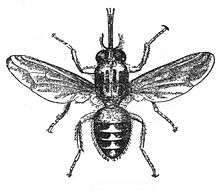Hippoboscoidea
Hippoboscoidea is a superfamily of the Calyptratae. The flies in this superfamily are blood-feeding obligate parasites of their hosts. Four families are often placed here:
- Glossinidae - Tsetse flies
- Hippoboscidae - Ked flies
- Nycteribiidae - Bat flies
- Streblidae - Bat flies
| Hippoboscoidea | |
|---|---|
 | |
| Tsetse fly (genus Glossina) | |
| Scientific classification | |
| Kingdom: | Animalia |
| Phylum: | Arthropoda |
| Class: | Insecta |
| Order: | Diptera |
| (unranked): | Eremoneura |
| (unranked): | Cyclorrhapha |
| Section: | Schizophora |
| Subsection: | Calyptratae |
| Superfamily: | Hippoboscoidea |
| Families | |
|
About 5, see text. | |
(Note that the Mystacinobiidae, while also a bat fly, belongs to the superfamily Oestroidea).
The Hippoboscidae are commonly called louse flies or ked flies. The bat flies are Nycteribiidae and Streblidae (along with Mystacinobiidae); the Streblidae are probably not monophyletic.[1] The family Glossinidae, monotypic as to genus, contains the tsetse flies, economically important as the vectors of trypanosomiasis. The enigmatic Mormotomyiidae are believed to belong to the Ephydroidea and not to Hippoboscoidea as previously construed.[2]
In older literature, this group is often referred to as the Pupipara ("pupa-bearers"), because, unlike virtually all other insects, most of the larval development takes place inside the mother's body, and pupation occurs almost immediately after "birth" – in essence, instead of laying eggs, a female lays full-sized pupae one at a time. In the strict sense, the Pupipara only encompass the Hippoboscidae, Nycteribiidae, and "Streblidae", which in older works were all included in the Hippoboscidae.
Development
Species of the Hippoboscoidea do not lay eggs. Instead, the larvae hatch in utero, are fed internally by "milk glands," and pass through three morphological stages before being deposited to pupate. This type of reproduction is termed as adenotrophic viviparity.[3]
References
- Petersen et al. (2007)
- Kirk-Spriggs, A.H., Kotrba, M. & Copeland, R.S. 2011. Further details of the morphology of the enigmatic African fly Mormotomyia hirsuta Austen (Diptera: Mormotomyiidae). African Invertebrates 52 (1): 145-165."Archived copy". Archived from the original on 2011-10-04. Retrieved 2011-10-04.CS1 maint: archived copy as title (link)
- Krafsur, E. S. "Tsetse flies: genetics, evolution, and role as vectors." Infection, Genetics and Evolution 9.1 (2009): 124-141.
| Wikimedia Commons has media related to Hippoboscoidea. |
| Wikispecies has information related to Hippoboscoidea |
Further reading
- Borror, Donald J.; Triplehorn, Charles A. & Johnson, Norman F. (1989): An Introduction to the Study of Insects (6th ed.). Saunders College Pub., Philadelphia. ISBN 0-03-025397-7
- Petersen, Frederik Torp; Meier, Rudolf; Kutty, Sujatha Narayanan & Wiegmann, Brian M. (2007): The phylogeny and evolution of host choice in the Hippoboscoidea (Diptera) as reconstructed using four molecular markers. Mol. Phylogenet. Evol. 45(1): 111–122. doi:10.1016/j.ympev.2007.04.023 (HTML abstract)